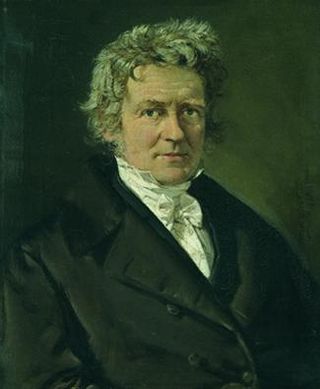Related Research Articles

Friedrich Wilhelm Bessel was a German astronomer, mathematician, physicist, and geodesist. He was the first astronomer who determined reliable values for the distance from the sun to another star by the method of parallax. Certain important mathematical functions were named Bessel functions after Bessel's death, though they had originally been discovered by Daniel Bernoulli before being generalised by Bessel.

1838 (MDCCCXXXVIII) was a common year starting on Monday of the Gregorian calendar and a common year starting on Saturday of the Julian calendar, the 1838th year of the Common Era (CE) and Anno Domini (AD) designations, the 838th year of the 2nd millennium, the 38th year of the 19th century, and the 9th year of the 1830s decade. As of the start of 1838, the Gregorian calendar was 12 days ahead of the Julian calendar, which remained in localized use until 1923.
The year 1920 in science and technology involved some significant events, listed below.
The year 1829 in science and technology involved some significant events, listed below.
The year 1837 in science and technology involved some significant events, listed below.
The year 1839 in science and technology involved some significant events, listed below.
The year 1840 in science and technology involved some significant events, listed below.
The year 1818 in science and technology involved some significant events, listed below.
The year 1817 in science and technology involved some significant events, listed below.
The year 1813 in science and technology involved some significant events, listed below.
The year 1811 in science and technology involved some significant events, listed below.
The year 1809 in science and technology involved some significant events, listed below.
The year 1792 in science and technology involved some significant events.
The year 1845 in science and technology involved some significant events, listed below.
The year 1853 in science and technology involved some significant events, listed below.
The year 1877 in science and technology involved some significant events, listed below.
The year 1844 in science and technology involved some significant events, listed below.
The year 1786 in science and technology involved some significant events.

Electrotyping is a chemical method for forming metal parts that exactly reproduce a model. The method was invented by a Prussian engineer Moritz von Jacobi in Russia in 1838, and was immediately adopted for applications in printing and several other fields. As described in an 1890 treatise, electrotyping produces "an exact facsimile of any object having an irregular surface, whether it be an engraved steel- or copper-plate, a wood-cut, or a form of set-up type, to be used for printing; or a medal, medallion, statue, bust, or even a natural object, for art purposes."
Events from the year 1838 in Scotland.
References
- ↑ Mulder, G. J. (1838). "Over Proteine en hare Verbindingen en Ontledingsproducten". Natuur- en Scheikundig Archief. 6: 87–162.
- ↑ Vickery, Hubert Bradford (1950). "The Origin of the Word Protein". Yale Journal of Biology and Medicine. 22 (5): 387–93. PMC 2598953 . PMID 15413335.
- ↑ Heinrich, Herbert (December 1938). "The Discovery of Galvanoplasty and Electrotyping" (PDF). Journal of Chemical Education . 15 (12): 565–575. Bibcode:1938JChEd..15..565H. doi:10.1021/ed015p565 . Retrieved 2012-06-21.[ permanent dead link ]
- ↑ Crilly, Tony (2007). 50 Mathematical Ideas you really need to know. London: Quercus. p. 69. ISBN 978-1-84724-008-8.
- ↑ "Down's syndrome". Whonamedit? . Retrieved 2011-04-13.
- ↑ Burke, James (1978). Connections. London: Macmillan. p. 239. ISBN 978-0-333-24827-0.
- ↑ "Steamship Curaçao". Archived from the original on 24 December 2010. Retrieved 2011-02-02.
- ↑ "Icons, a portrait of England 1820-1840". Archived from the original on 22 September 2007. Retrieved 2007-09-12.
- ↑ Grantham, John (1859). On Iron Ship Building (2nd ed.). London: Lockwood. pp. 13–14.
- ↑ Patent No. 7615, Obtaining motive power from inflammable gases by compression and explosion.
- ↑ Clerk, Dugald (1897). Gas and Oil Engines. London: Longman Green & Co.
- ↑ Heinrich, Herbert (December 1938). "The Discovery of Galvanoplasty and Electrotyping". Journal of Chemical Education. 15 (12): 566–575.
- ↑ "Copley Medal | British scientific award". Encyclopedia Britannica. Retrieved 22 July 2020.